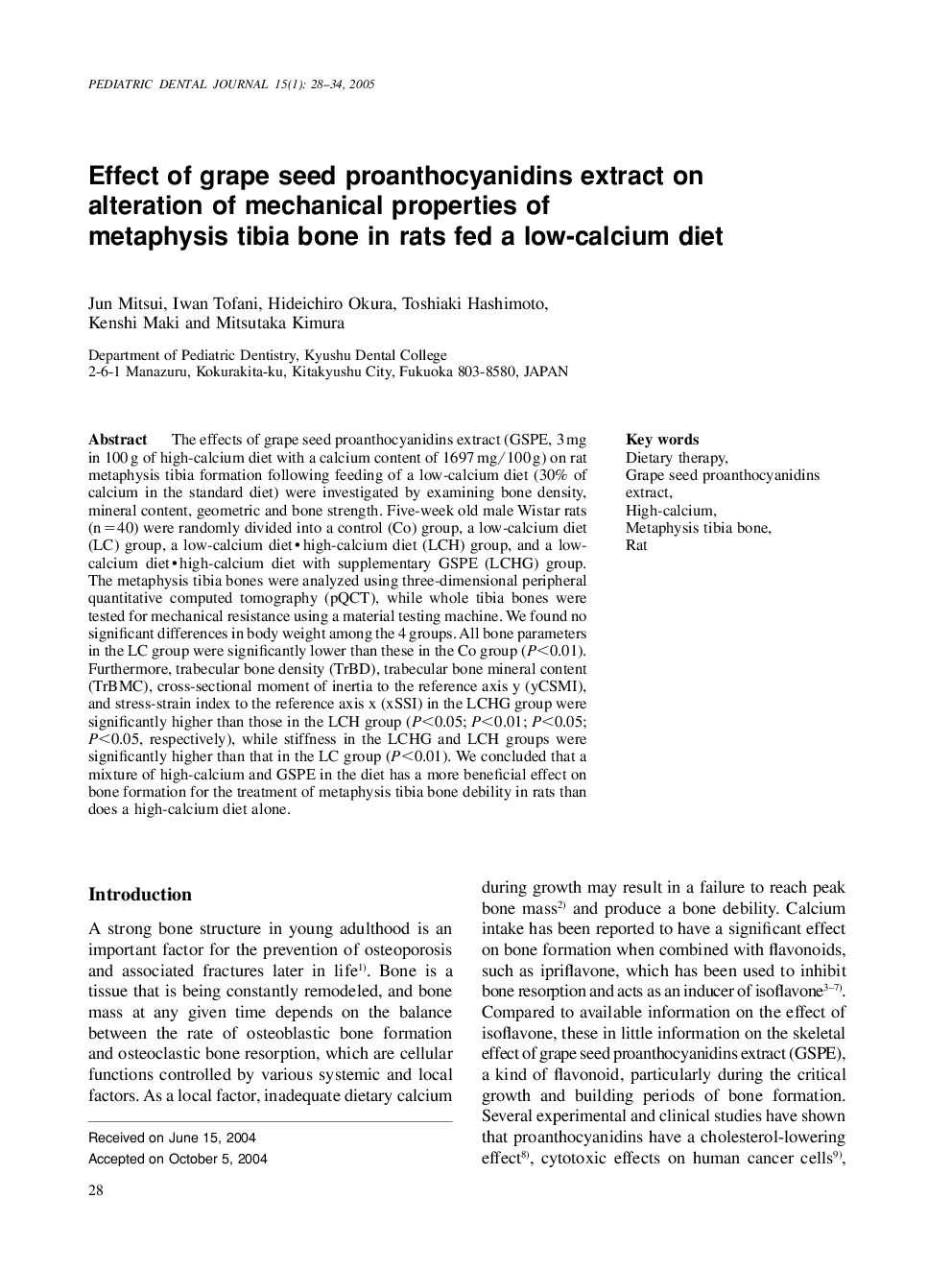| Article ID | Journal | Published Year | Pages | File Type |
|---|---|---|---|---|
| 9219936 | Pediatric Dental Journal | 2005 | 7 Pages |
Abstract
The effects of grape seed proanthocyanidins extract (GSPE, 3 mg in 100 g of high-calcium diet with a calcium content of 1697 mg/100 g) on rat metaphysis tibia formation following feeding of a low-calcium diet (30% of calcium in the standard diet) were investigated by examining bone density, mineral content, geometric and bone strength. Five-week old male Wistar rats (n = 40) were randomly divided into a control (Co) group, a low-calcium diet (LC) group, a low-calcium diet
- high-calcium diet (LCH) group, and a lowcalcium diet
- high-calcium diet with supplementary GSPE (LCHG) group. The metaphysis tibia bones were analyzed using three-dimensional peripheral quantitative computed tomography (pQCT), while whole tibia bones were tested for mechanical resistance using a material testing machine. We found no significant differences in body weight among the 4 groups. All bone parameters in the LC group were significantly lower than these in the Co group (PÂ <Â 0.01). Furthermore, trabecular bone density (TrBD), trabecular bone mineral content (TrBMC), cross-sectional moment of inertia to the reference axis y (yCSMI), and stress-strain index to the reference axis x (xSSI) in the LCHG group were significantly higher than those in the LCH group (PÂ <Â 0.05; PÂ <Â 0.01; PÂ <Â 0.05; PÂ <Â 0.05, respectively), while stiffness in the LCHG and LCH groups were significantly higher than that in the LC group (PÂ <Â 0.01). We concluded that a mixture of high-calcium and GSPE in the diet has a more beneficial effect on bone formation for the treatment of metaphysis tibia bone debility in rats than does a high-calcium diet alone.
- high-calcium diet (LCH) group, and a lowcalcium diet
- high-calcium diet with supplementary GSPE (LCHG) group. The metaphysis tibia bones were analyzed using three-dimensional peripheral quantitative computed tomography (pQCT), while whole tibia bones were tested for mechanical resistance using a material testing machine. We found no significant differences in body weight among the 4 groups. All bone parameters in the LC group were significantly lower than these in the Co group (PÂ <Â 0.01). Furthermore, trabecular bone density (TrBD), trabecular bone mineral content (TrBMC), cross-sectional moment of inertia to the reference axis y (yCSMI), and stress-strain index to the reference axis x (xSSI) in the LCHG group were significantly higher than those in the LCH group (PÂ <Â 0.05; PÂ <Â 0.01; PÂ <Â 0.05; PÂ <Â 0.05, respectively), while stiffness in the LCHG and LCH groups were significantly higher than that in the LC group (PÂ <Â 0.01). We concluded that a mixture of high-calcium and GSPE in the diet has a more beneficial effect on bone formation for the treatment of metaphysis tibia bone debility in rats than does a high-calcium diet alone.
Keywords
Related Topics
Health Sciences
Medicine and Dentistry
Dentistry, Oral Surgery and Medicine
Authors
Jun Mitsui, Iwan Tofani, Hideichiro Okura, Toshiaki Hashimoto, Kenshi Maki, Mitsutaka Kimura,
